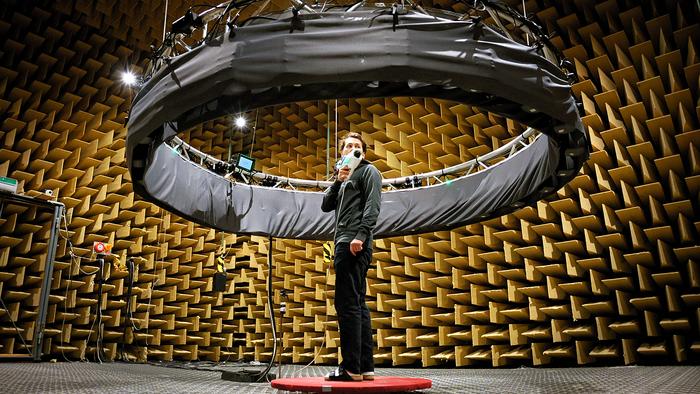
As the prevalence of electric vehicles surges globally, they bring a vital yet complex aspect of road safety into focus: the auditory alerts designed for vulnerable road users. A new study from Chalmers University of Technology in Sweden has uncovered that many of the acoustic warning signals used by these vehicles are not as effective as one might hope, particularly in distinguishing their direction. This finding raises critical questions about pedestrian safety, as more electric cars fill urban streets, many of which emit similar sounds that can be nearly indistinguishable from one another.
In a comprehensive experimental study, researchers set out to evaluate how effectively humans can locate various Acoustic Vehicle Alerting System (AVAS) signals associated with electric and hybrid vehicles. The study tested three prevalent signal types at low speeds in controlled settings that mimic the acoustics of real-world environments. Through meticulous examination, it became clear that the modern warning signals are significantly harder to localize accurately compared to traditional internal combustion engine sounds.
This revelation is particularly important considering that electric vehicles are typically designed to operate at lower noise levels, which has been a welcome change for many. However, it introduces a paradox: as vehicles become quieter to reduce environmental noise pollution, they simultaneously pose a greater challenge for pedestrians, cyclists, and other road users who rely on auditory cues for safety. The study led by doctoral student Leon Müller revealed that one specific signal proved exceptionally difficult for test subjects to locate, especially when multiple electric vehicles were present at the same time.
.adsslot_IdlYO6MLq8{width:728px !important;height:90px !important;}
@media(max-width:1199px){ .adsslot_IdlYO6MLq8{width:468px !important;height:60px !important;}
}
@media(max-width:767px){ .adsslot_IdlYO6MLq8{width:320px !important;height:50px !important;}
}
ADVERTISEMENT
The study’s findings underscore a significant gap in current automotive standards that primarily focus on the detectability of these warning sounds rather than their directional clarity. The researchers pointed out that regulations do not demand manufacturers to consider how easily pedestrians can pinpoint the location of an electric vehicle, which is crucial in environments like parking lots where several similar vehicles may produce identical alerts simultaneously.
Of particular note is the study’s finding that a majority of test participants failed to determine the source of the warning signals when surrounded by these electric vehicles. The researchers also indicated that in real-world situations, background noise—caused by other vehicles, pedestrians, and urban infrastructure—compounds the problem further. This highlights the necessity for an updated framework in automotive sound design, one that accounts for how pedestrians interact with sound in a busy public setting.
Car manufacturers adhere to international guidelines mandating vehicles to emit warning signals when traveling at low speeds to mitigate accidents involving pedestrians and cyclists. In various jurisdictions, including Europe, Beijing, and Tokyo, electric and hybrid vehicles must generate specific noise types to ensure they can be detected by those who do not have the benefit of situational awareness. Meanwhile, similar regulations in the United States require such signals to be activated at speeds as high as 30 kilometers per hour.
However, despite meeting the established requirements, the inherent design of these signals often lacks a comprehensive understanding of how people process sound in everyday scenarios. Wolfgang Kropp, a professor of acoustics at Chalmers, emphasized that many of the sound tests conducted were performed in quiet environments, failing to replicate the complexity of actual traffic conditions. This oversight could lead to potential traffic hazards, especially for those who rely heavily on their ability to hear approaching vehicles.
Crucial insights emerged from the controlled experiments carried out in soundproofed chambers at Chalmers. During this study, 52 participants were center-stage as they attempted to identify the directionality of sound generated by a ring of 24 loudspeakers that emulated the warning signals of electric vehicles. The researchers simulated backgrounds akin to quiet car parks, where test subjects had to quickly locate the sound source. Interestingly, the particularly challenging two-tone signal from multiple vehicles presented an insurmountable barrier for participants, none of whom could determine all signal directions within the limited time provided.
This issue extends beyond perceived dangers for pedestrians in urban spaces; it touches on the necessity for rethinking sound design within the automotive industry. Leon Müller noted that the previous internal combustion engine signals created a broad sound spectrum that included high-pitched and low-pitched tones, making it easier for people to discern their origin. This clarity is drastically diminished when utilizing fixed tones at singular frequencies often employed in contemporary electric vehicle alerts, making it crucial for future sound development initiatives.
The study suggests a balanced approach is necessary, one that maintains the quieter operation of electric vehicles while enhancing their acoustic presence in a way that’s both effective and unobtrusive for humans. Familiarity plays a significant role here; sounds our brains are accustomed to are naturally easier to identify. This revelation compels researchers to rethink acoustic warnings in terms of human auditory perception.
As the discussion on traffic safety evolves, it will become imperative to explore new types of AVAS signals that can generate more robust auditory cues without becoming a nuisance. Leaders in acoustical research at Chalmers emphasize the urgent need to devise sound profiles capable of ensuring pedestrian safety while minimizing unnecessary auditory distractions, successfully navigating the fine line between sound effectiveness and quality of life.
The Chalmers research team sees a considerable need for continued investigations into how non-vehicle users perceive AVAS signals, especially given that existing frameworks predominantly revolve around the distance at which these sounds can be identified rather than their capacity for precise location identification. The critical discourse surrounding sound design in electric vehicles will significantly benefit from further in-depth studies focused on user reactions to realistic traffic scenarios involving multiple electric vehicles emitting the same types of signals.
In conclusion, the findings of this landmark study highlight an essential area of development in the automotive sector reflective of expanding urban mobility solutions. As electric vehicles become an integral part of our transportation systems, building an infrastructure equipped with effective, intelligible sound signals is vital to ensure road safety for all. Future research must prioritize the harmonization of sound design that is responsive to the realities of human perception within urban environments, thus paving the way to a safer coexistence of electric vehicles and pedestrians alike.
Subject of Research: Acoustic Vehicle Alerting System (AVAS) Signals for Electric Vehicles
Article Title: Auditory Localization of Multiple Stationary Electric Vehicles
News Publication Date: 24-Mar-2025
Web References: Chalmers University of Technology
References: The Journal of the Acoustical Society of America
Image Credits: Chalmers/Unsplash
Keywords
Electric Vehicles, Acoustic Safety Signals, Traffic Safety, Sound Perception, Human Factors, Urban Mobility, Automotive Engineering, Environmental Noise, Audiovisual Communication, Vehicle Regulations.
Tags: advancements in vehicle auditory alertschallenges in acoustic warning signalsdistinguishing electric car soundseffectiveness of Acoustic Vehicle Alerting Systemselectric vehicle safetyidentifying vehicle direction for pedestriansimpact of quiet vehicles on road safetylow-speed electric vehicle soundspedestrian awareness of electric carspedestrian safety in urban environmentsresearch on electric vehicle noiseurban road safety for vulnerable users



